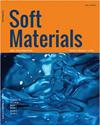羧甲基黄原胶/双壁碳纳米管杂化水凝胶纳米复合材料的合成
IF 1.4
4区 材料科学
Q4 MATERIALS SCIENCE, MULTIDISCIPLINARY
引用次数: 3
摘要
摘要在羧甲基黄原胶基水凝胶中加入双壁碳纳米管,以改善这些纳米复合材料的机械性能和药物释放(双氯芬酸)性能,从而在生物医学领域具有潜在的应用前景。通过黄原胶与一氯乙酸的酯化反应合成了羧甲基黄原胶,并通过FTIR分析证实了接枝反应。与天然黄原胶相比,所获得的羧甲基衍生物表现出更高的亲水取代度。使用生的或改性的黄原胶制备的纳米复合材料在物理性能方面进行了表征,我们证明了在羧甲基黄原胶的情况下,粘弹性增加了一个数量级,纳米管在水凝胶基质中的分布也得到了改善。纳米管的加入提高了双氯芬酸的捕获效率,最高可达74wt%。同时纳米管也允许分子的缓慢释放。进行了一项体外研究,以确保接枝到改性CMX上的CNT在活性成分的扩散过程中不会释放。本文章由计算机程序翻译,如有差异,请以英文原文为准。
Synthesis of carboxymethyl Xanthan/ double-walled carbon nanotube hybrid hydrogel nanocomposite for transdermal release of drug
ABSTRACT The inclusion of double-walled carbon nanotubes in carboxymethyl xanthan-based hydrogels was developed in order to improve both mechanical and drug release (diclofenac) properties of these nanocomposites for potential application in the biomedical field. The synthesis of carboxymethyl xanthan was carried out by an esterification reaction between xanthan gum and monochloroacetic acid, and the grafting was confirmed by FTIR analysis. The obtained carboxymethyl derivatives exhibited higher hydrophilicity degrees of substitution compared to the native xanthan gum. The nanocomposites prepared using either raw or modified xanthan gum were characterized in terms of physical properties, and we evidenced both an increase in viscoelasticity by one order of magnitude and an improved distribution of the nanotubes within the hydrogel matrix in the case of the carboxymethyl xanthan. The trapping efficiency of diclofenac was improved by the addition of the nanotubes, reaching up to 74 wt %. While the nanotubes also allowed a slower release of the molecule. An in-vitro study was carried out to ensure that the CNTs grafted onto the modified CMX were not released during the diffusion of the active ingredient.
求助全文
通过发布文献求助,成功后即可免费获取论文全文。
去求助
来源期刊

Soft Materials
工程技术-材料科学:综合
CiteScore
2.90
自引率
0.00%
发文量
21
审稿时长
2.2 months
期刊介绍:
Providing a common forum for all soft matter scientists, Soft Materials covers theory, simulation, and experimental research in this rapidly expanding and interdisciplinary field. As soft materials are often at the heart of modern technologies, soft matter science has implications and applications in many areas ranging from biology to engineering.
Unlike many journals which focus primarily on individual classes of materials or particular applications, Soft Materials draw on all physical, chemical, materials science, and biological aspects of soft matter. Featured topics include polymers, biomacromolecules, colloids, membranes, Langmuir-Blodgett films, liquid crystals, granular matter, soft interfaces, complex fluids, surfactants, gels, nanomaterials, self-organization, supramolecular science, molecular recognition, soft glasses, amphiphiles, foams, and active matter.
Truly international in scope, Soft Materials contains original research, invited reviews, in-depth technical tutorials, and book reviews.
 求助内容:
求助内容: 应助结果提醒方式:
应助结果提醒方式:


